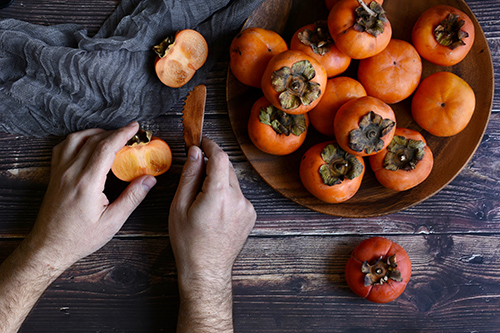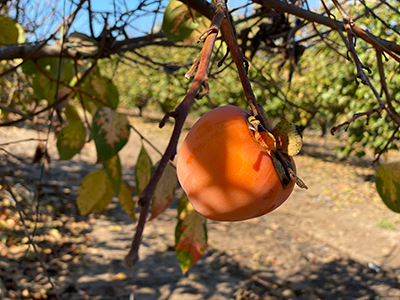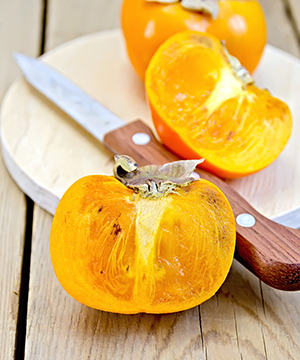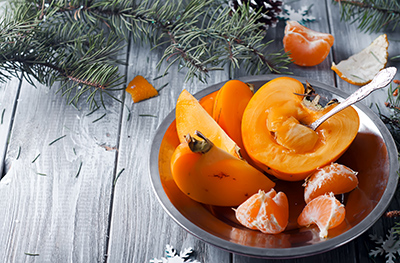Contents
The Greeks knew about the health benefits of persimmon centuries ago. Whether orange or bright red, persimmons evoke blazing flames. Their scientific name, Diospyros, is Greek for “fire of Zeus.” However, once eaten, persimmons act entirely contrary to what would be expected of a “blazing fire.” They are an exceptional emollient for the digestive tract, particularly in the intestine.

Persimmon Nutritional Facts
The persimmon’s gelatinous pulp contains no proteins or fats. However, the following substances are noteworthy:
SUGARS – Each one hundred grams of persimmon pulp contains fifteen grams of sugar. The most plentiful are fructose, followed by glucose and saccharose.
PECTIN and MUCILAGE – These complex carbohydrates are responsible for the gelatinous consistency of persimmon pulp. Persimmons and apples are among the most pectin-rich fruits (one percent). Pectin and mucilage comprise the essential components of what is known as soluble vegetable fiber, which represents 3.6 percent of the persimmon’s weight.
Pectin and mucilage retain water, increasing fecal volume and facilitating evacuation. They also contain sugars, which keep them from being rapidly absorbed (as with pure sugar) but at a controlled pace. They also retain the cholesterol found in the digestive tract from animal-based foods, removing a portion through the feces. But the immediate effect of these pectin and mucilage is soothing and reducing inflammation in the walls of the digestive tract, particularly toward the end, the large intestine.
TANNINS – These phenolic compounds are potent astringents. They coagulate proteins, forming a dry-resistant coating on the mucosa. Tannins are immediately recognized for their harsh taste: the more tannins, the greater the astringent effect. There are varieties of persimmon with higher tannin content than others. However, in all of them, the tannin almost disappears during the final stages of ripening. The maximum tannin concentration in persimmons is in October, when the fruit has not reached its peak ripeness, usually in November in the Northern Hemisphere.
CAROTENOIDS – These are substances derived from beta-carotene, from which the body produces vitamin A. For this reason, they are called provitamin A. Contemporary interest in carotenoids is due to their proven antioxidant properties, which prevent cellular aging, stop the process of arteriosclerosis, and act to prevent cancer.

Among the fifteen carotenoids in persimmons, lycopene (also found in tomatoes) and cryptoxanthin predominate. These carotenoids are responsible for persimmons’ orange or reddish color. Persimmons are among the richest fruits in carotenoids (provitamin A). One hundred grams of persimmon provides 22 percent of the adult’s daily need for vitamin A. One medium persimmon weighing 250 grams is enough to supply half the RDA (Recommended Daily Allowance) for this vitamin.
VITAMIN C – Persimmons contain 16 mg per one hundred grams. One medium persimmon (250 grams) supplies 40 percent of the daily need for this vitamin. While persimmons are not the richest fruit in vitamin C, they contain a significant amount sufficient to facilitate the absorption of the iron they also have.
IRON – This is the most abundant mineral (in terms of daily need) contained in the persimmon, after potassium. A 250-gram persimmon provides ten percent of an adult’s daily requirement for iron, which is considerable for fresh fruit.
Health Benefits of Persimmon
The following are the medicinal applications of the persimmon:

1. Health benefits of persimmon (INTESTINAL DISORDERS) – Persimmons soothe and dry the digestive system’s walls. This is due to the combined action of their tannin (astringents) and their pectin and mucilage (emollient). The astringent effect is more intense in certain varieties and those not completely ripe. In addition to their astringent effect, persimmons are anti-inflammatory because of their many pectin and mucilage content. The carotenoids they contain also contribute to this effect.
They are beneficial in cases of diarrhea or colitis (inflammation of the large intestine) from any cause. Three to six persimmons a day aid in quickly regulating intestinal movement and reducing inflammation in the digestive tract’s mucosa. Completely ripe persimmons of softer varieties contain little tannin and are less astringent. A soft pulp with no harshness characterizes these.
This means they are less effective against diarrhea than more astringent or less ripe varieties. However, they retain their anti-inflammatory effect on the intestine, which is helpful in chronic colitis, intestinal spasms (cramps), excess gas, and irritable bowel syndrome.
2. Health benefits of persimmon (CARDIOVASCULAR CONDITIONS) – Persimmons are low in fat and sodium yet rich in carotenoids, which protect the arteries. They are highly recommended for those with general arteriosclerosis, high blood pressure, and cardiovascular conditions.
3. Health benefits of persimmon (ANEMIA) – Although persimmons’ iron content is not exceptionally high, it is highly absorbable because the fruit also contains vitamin C. Eating ample amounts of persimmons is recommended in cases of iron deficiency anemia, the most widespread type of anemia.
4. Health benefits of persimmon (DIABETES) – Although persimmons are a sweet fruit, people with diabetes tolerate them well for two reasons:
- More than half of their fifteen percent sugars are FRUCTOSE, and natural sugar is found in fruit. This type of sugar requires less insulin for utilization in the cells. Because of this, people with diabetes, whose pancreas produces less insulin, tolerate and absorb fructose better than other sugars.
- Persimmons’ abundant vegetable fiber in the form of pectin retains sugars in the intestine, releasing them little by little. Thus, the diabetic experiences no rapid burst of fructose and glucose into the bloodstream, which is harmful.
Persimmons can be safely eaten by people with diabetes, who may benefit from their positive action on the digestive system and their carotenoid and iron content.
American Persimmon
Another species of persimmon, Diospyros virginiana L., is grown in North America. It is also known as wild persimmon. Its composition resembles Japanese persimmon but contains more sugars, minerals, and vitamin C.
Persimmon Scientific Facts

- Scientific name – Diospyros kaki L.
- Other names – Kaki fruit, Sharon fruit, Chinese fig, and Common persimmon.
- French – Kaki.
- Spanish – Caqui, palosanto.
- German – Kaki.
- Description – The aggregate fruit of the persimmon tree, a deciduous tree growing to 4 m of the botanical family Ebenaceae. The fruit is eaten almost overripe.
- Environment – Originally from Japan, its cultivation has spread through semitropical areas in Southern Europe and the American continent.
How to Use and Prepare Persimmon
- FRESH – Edible persimmons are only available in the fall, so it is necessary to take advantage of the opportunity to enjoy them in abundance. In case of diarrhea, up to six a day may be eaten.
- PERSIMMON PUREE – This is a highly prized ingredient in cremes, jams, jellies, and compotes. It goes well with tofu, cottage cheese, yogurt, and cream.
DISCLAIMER: All content on this website is presented solely for educational and informational objectives. Do not rely on the information provided as a replacement for advice, diagnosis, or treatment from a qualified medical expert. If you are pregnant, nursing, or have any preexisting medical concerns, talk to your doctor before using any herbal or natural medicines.
REFERENCES
- George D. Pamplona-Roger, M.D. “Encyclopedia of Foods and Their Healing Power.” George D. Pamplona-Roger, M.D. Encyclopedia of Foods and Their Healing Power. Trans. Annette Melgosa. Vol. 2. Chai Wan: Editorial Safeliz, 2005. 222, 223, 224. Print.
- WebMD: https://www.webmd.com/diet/health-benefits-persimmon
- Journal of Functional Foods: https://www.sciencedirect.com/science/article/pii/S2211926423003065
- Journal of Medicinal Food: https://www.ncbi.nlm.nih.gov/pmc/articles/PMC4817420
Last update on 2025-06-04 / Affiliate links / Images from Amazon Product Advertising API





